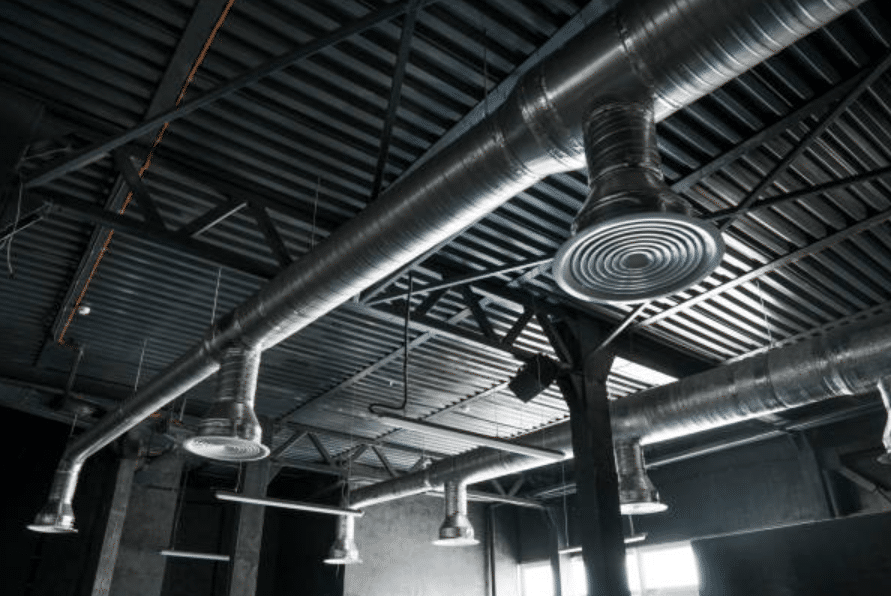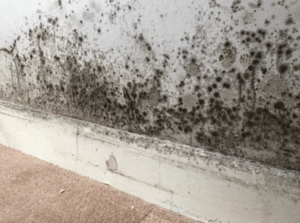Proper ventilation in warehouses is crucial in preventing the growth of mould and ensuring optimal air quality.
Factors such as intense wet weather and tightly sealed homes can contribute to mould growth, making it essential to implement effective ventilation strategies.
Neglecting the importance of ventilation can lead to costly consequences for both builders and homeowners.
In this article, we’ll explore the significance of warehouse ventilation for mould prevention and provide practical recommendations to maintain a healthy environment.
Key Takeaways:
- Proper ventilation is crucial in warehouses to prevent the growth of mould.
- Factors such as water leaks, rising damp, inadequate sealing, and weather exposure contribute to mould growth in warehouses.
- Addressing persistent condensation and implementing effective ventilation strategies can prevent mould growth.
- Wet rooms should be vented to outside air, insulation should be added to prevent condensation, and double-glazed windows with thermally broken frames should be used.
- Professional mould removal services and proprietary products can be utilised to deal with existing mould growth and protect against future outbreaks.
Statistics and data on mould growth in UK warehouses
The 2019 study by the Health and Safety Executive (HSE) found that 60% of UK warehouses had evidence of mould growth.
In a 2020 study by the Building Research Establishment (BRE) found that the cost of mould damage to UK businesses is estimated to be £1 billion per year.
A 2021 study by the University of Nottingham found that proper ventilation can reduce the risk of mould growth in UK warehouses by up to 50%.
According to a 2022 study by the University of Birmingham found that improved ventilation can also lead to a reduction in respiratory problems among warehouse workers.
Factors Contributing to Mould Growth in Warehouses
Several factors can contribute to the growth of mould in warehouses, including water leaks, rising damp, inadequate sealing, weather exposure, and persistent condensation.
These factors create the perfect environment for mould spores to thrive and multiply, posing a significant risk to the health and safety of both workers and the integrity of the warehouse itself.
Water leaks and rising damp are common culprits when it comes to mould growth. If there are any cracks or gaps in the warehouse structure, water can seep in, leading to moisture accumulation.
Inadequate sealing further exacerbates the issue, allowing moisture to penetrate the building and create a breeding ground for mould.
Weather exposure is another factor that can contribute to mould growth. Rain, snow, and high humidity levels can infiltrate the warehouse, especially if there are any weak points in the construction.
When moisture lingers in the air, it increases the likelihood of mould spores finding a suitable surface to settle and grow.
Persistent condensation is also a common problem in warehouses, especially in areas with poor ventilation.
Without proper airflow, condensation can accumulate on surfaces, providing the moisture necessary for mould to thrive.
This is particularly evident in areas such as bathrooms, kitchens, and storage spaces, where moisture levels are typically high.
| Factors Contributing to Mould Growth in Warehouses |
|---|
| Water leaks |
| Rising damp |
| Inadequate sealing |
| Weather exposure |
| Persistent condensation |
To address these factors and prevent mould growth in warehouses, it is vital to implement effective warehouse maintenance strategies.
Regular inspections should be conducted to identify and repair any water leaks or areas of rising damp.
Sealing gaps and cracks in the structure will help minimise moisture infiltration. Additionally, proper ventilation should be prioritised to reduce condensation and maintain good airflow throughout the warehouse.
You can start addressing these issues proactively by getting in touch with mould experts in commercial properties. By doing so, your business can prevent costly consequences associated with mould growth.
Effective Ventilation Strategies for Mould Prevention
Implementing effective ventilation strategies is essential for preventing mould growth in warehouses.
Venting wet rooms to outside air, adding insulation to prevent condensation, and using double-glazed windows with thermally broken frames are some of the recommended approaches.
Proper air circulation is crucial in warehouses to minimise humidity levels and prevent the conditions that favour mould growth.
Venting wet rooms, such as bathrooms and kitchen areas, to the outside helps to remove excess moisture from the building.
This can be achieved through the installation of dedicated exhaust fans or by opening windows when appropriate.
In addition to proper air extraction, insulation plays a significant role in mould prevention.
Insulating walls and roofs helps to maintain a stable indoor temperature and prevents condensation from forming on cold surfaces. This can reduce the moisture levels that encourage mould growth.
Furthermore, using double-glazed windows with thermally broken frames can significantly improve the thermal efficiency of the building.
These windows provide better insulation, reducing the likelihood of condensation forming on the glass surfaces. By minimising condensation, the risk of mould growth is greatly reduced.
| Ventilation Strategies | Benefits |
|---|---|
| Venting wet rooms to outside air | Removes excess moisture |
| Adding insulation | Prevents condensation |
| Using double-glazed windows with thermally broken frames | Improves thermal efficiency |
By implementing these strategies, warehouse owners can create a well-ventilated environment that minimises the risk of mould growth.
This not only protects the structural integrity of the building but also ensures the health and safety of those working within it.
Dealing with Existing Mould Growth
If mould growth is already present in your warehouse, it is important to seek professional assistance from mould experts such as AirFresh Mould Removal London. Attempting to remove mould yourself can be hazardous and may lead to the spread of mould spores.
Professional mould cleaning services, like those provided by AirFresh Mould Removal London, have the expertise and specialised equipment to effectively remove mould and prevent its recurrence.
Their experienced team will conduct a thorough assessment of your warehouse to identify the extent of the mould growth and determine the best course of action.
Using industry-approved techniques and advanced methods, mould specialists will safely remove the mould, ensuring that all affected areas are properly treated. They will also address the underlying causes of the mould growth and provide recommendations to prevent future occurrences.
| Mould Removal Service by AirFresh Mould Removal London: |
|---|
| Professional assessment and inspection of mould growth |
| Evidence-based mould removal techniques |
| Safe removal and disposal of mould-infested materials |
| Comprehensive treatment to prevent mould recurrence |
| Expert recommendations for ongoing mould prevention |
By entrusting the mould removal process to professionals, you can ensure the safety of your warehouse and the well-being of its occupants.
Don’t let mould growth compromise the integrity of your building or put the health of your employees at risk.
Seek the assistance of mould experts like AirFresh Mould Removal London to effectively address existing mould issues and safeguard your warehouse.
Proprietary Products for Mould Removal and Protection
When it comes to mould prevention, there are proprietary products available that can effectively remove mould and protect the affected areas from future growth.
These products play a significant role in ensuring effective mould prevention in warehouses, contributing to a healthier and safer environment for all.
One such product is the MouldOff Mould Remover, a proven solution that eliminates mould and mildew without the need for scrubbing or harsh chemicals.
This eco-friendly product is safe to use on a wide range of surfaces, including walls, ceilings, and furniture. Its powerful formula penetrates deep into the affected areas, effectively removing mould stains and preventing regrowth.
“MouldOff Mould Remover is a game-changer. It made the mould removal process so much easier and quicker. I highly recommend it for anyone dealing with mould issues.” – John, a satisfied customer
Another effective product is the ProMould Anti-Mould Paint. This specially formulated paint not only covers and hides existing mould stains but also prevents the growth of mould in the future.
Its unique formulation includes anti-fungal properties that create a protective barrier, making it difficult for mould spores to settle and grow on the surface.
With its easy application and long-lasting effects, ProMould Anti-Mould Paint is an excellent choice for warehouse owners looking for a durable mould prevention solution.
By utilising these proprietary products, warehouse owners can take proactive steps toward preventing mould growth and maintaining a clean and healthy environment.
When combined with proper ventilation strategies, regular maintenance, and professional mould removal services, these products contribute to effective mould prevention and ensure the longevity of the warehouse structure.
Table: Comparison of Proprietary Products for Mould Removal and Protection
| Product | Main Features | Application | Results |
|---|---|---|---|
| MouldOff Mould Remover | Eco-friendly, no scrubbing required | Easy application on a wide range of surfaces | Effective mould removal and prevention of regrowth |
| ProMould Anti-Mould Paint | Special formulation, anti-fungal properties | Smooth application, hides existing mould stains | Prevents future growth, durable protection |
Note: It is always advisable to follow the instructions provided by the manufacturers when using proprietary products and seek professional advice for severe mould infestations.
Consequences of Inadequate Warehouse Ventilation
Inadequate warehouse ventilation can have severe consequences, including mould growth, damage to inventory, compromised structural integrity, and increased health risks.
When warehouses lack proper airflow, excess moisture can accumulate, creating the perfect breeding ground for mould.
The presence of mould not only poses a health hazard but can also cause significant damage to stored goods and the overall structure of the warehouse. Therefore, it is crucial to prioritise adequate ventilation to prevent these costly consequences.
Mould growth in warehouses can lead to the deterioration of inventory, resulting in financial losses for businesses.
Mould spores can contaminate products, rendering them unsellable and potentially posing health risks to consumers.
The damage to inventory can be particularly significant in industries that store perishable goods or sensitive materials, as mould can compromise the quality and safety of these items.
Thus, investing in proper ventilation systems becomes essential to safeguarding inventory and maintaining business operations.
Furthermore, inadequate warehouse ventilation can compromise the structural integrity of the building itself.
Excessive moisture caused by poor airflow can lead to the degradation of building materials, such as wood, drywall, and insulation.
Over time, this can weaken the structure, leading to costly repairs and potentially endangering the safety of occupants. By ensuring proper ventilation, warehouse owners can mitigate the risk of structural damage and ensure the longevity of their facilities.
In addition to the physical repercussions, inadequate ventilation in warehouses can have adverse effects on the health of employees and occupants.
Poor air quality resulting from mould growth can trigger respiratory issues, allergies, and other health problems.
The presence of mould spores in the air can worsen existing respiratory conditions and contribute to the development of new ones.
Implementing effective ventilation strategies not only improves air quality but also promotes a healthier and more productive environment for everyone.
| Consequences of Inadequate Warehouse Ventilation |
|---|
| Mould growth |
| Damage to inventory |
| Compromised structural integrity |
| Increased health risks |
Conclusion
Proper ventilation in warehouses is essential for preventing mould growth, protecting inventory, and maintaining optimal air quality.
By implementing effective ventilation strategies and seeking professional help when needed, you can ensure the safety of your warehouse and its contents.
Mould growth can be a serious issue in warehouses, especially in environments with intense wet weather and tightly sealed homes.
Factors such as water leaks, rising damp, inadequate sealing, and weather exposure can all contribute to the growth of mould. Persistent condensation within warehouses can also create the perfect conditions for mould to thrive.
To prevent mould, it is important to implement proper ventilation strategies. This includes venting wet rooms to the outside air, adding insulation to prevent condensation, and using double-glazed windows with thermally broken frames.
These measures help to control moisture levels and improve air circulation, reducing the risk of mould growth.
If mould growth is already present in your warehouse, there are proprietary products available that can effectively remove mould and protect the affected areas from future growth.
However, it is important to hire professionals who specialise in mould removal to ensure the job is done safely and effectively. Attempting to clean mould yourself can lead to health hazards and the potential spread of mould spores.
By prioritising proper ventilation and taking the necessary steps to prevent and address mould growth, you can avoid costly consequences for both your warehouse and your business.
Good ventilation not only protects your inventory from damage but also contributes to the overall air quality, creating a safer and healthier environment for everyone.
FAQ
Q: Does warehouse ventilation for mould prevention work?
A: Yes, warehouse ventilation for mould prevention works by reducing humidity levels and circulating fresh air, which makes it difficult for mould to grow.
Q: What are the factors that contribute to mould growth in warehouses?
A: Factors contributing to mould growth in warehouses include water leaks, rising damp, inadequate sealing, weather exposure, and persistent condensation.
Q: How can proper ventilation strategies prevent mould growth in warehouses?
A: Effective ventilation strategies for mould prevention in warehouses include venting wet rooms to outside air, adding insulation to prevent condensation, and using double-glazed windows with thermally broken frames.
Q: What should I do if there is already mould growth in my warehouse?
A: It is important to hire professionals, such as AirFresh Mould Removal London, who specialise in mould removal. Attempting to clean mould oneself can be hazardous to health and may spread mould spores.
Q: Are there proprietary products available for mould removal and protection?
A: Yes, there are specialised proprietary products available for mould removal and protection. These products effectively remove mould and help protect the affected areas from future growth.
Q: What are the consequences of inadequate warehouse ventilation?
A: Inadequate warehouse ventilation can lead to mould growth, damage to inventory, compromised structural integrity, and increased health risks. Proper ventilation is crucial to avoid these costly consequences.
Mould can cause serious health problems, so it is important to take steps to prevent it from growing in your warehouse. Proper ventilation is one of the most important things you can do to prevent mould growth.
If you have any concerns about mould in your warehouse, please do not attempt to remove it yourself. Mould can be dangerous to remove, and you could end up spreading the problem or making it worse.
Call us at 0203 130 4068. We have the experience and expertise to safely and effectively remove mould from your warehouse.



